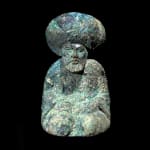Bronze Chess Piece of the Caliph Harun al-Rashid, 780 CE - 850 CE
Bronze
height 8.6 cm
height 3 3/8 in
height 3 3/8 in
AM.0098
This extremely attractive figurine in bronze is actually a chess piece reproducing a middle-aged seated male and very possibly representing the Caliph Harun al-Rashid himself. The man is of a...
This extremely attractive figurine in bronze is actually a chess piece reproducing a middle-aged seated male and very possibly representing the Caliph Harun al-Rashid himself.
The man is of a decidedly distinguished bearing, wearing an exaggeratedly oversized turban, his bearded face cast in low relief.
The figure is dressed in a long robe which covers his arms to the wrists; the hands are folded reflectively on the lap. The detailing of the robe, with its folds and creases, is clearly marked out on the reverse of the figure, whereas the turban is decorated with swirled lines around a central apex.
The piece has been meticulously cleaned by a team of experts as to show the sparkling patina of the metal. Further research showed that the object was cast by using two mould halves, the two pieces later joined together. Internally hollow, with a flange that was probably used for attaching the piece to a base or some other substructure. In any case, this is an extremely unusual and highly desirable piece from the period of the Islamic Golden Age.
The caliphate of Harun al-Rashid marked a cultural high point in the administrations of the Abbasid caliphs from 786 to 809. His surname literally translated as “the Just/the Upright/ the Rightly-Guided”, Harun al-Rashid was born in 763 and became the fifth Abbasid Caliph in 786. By the time of his death in 809, his reign had been marked by a military, administrative and politically strong leadership, while there has also been a significant bloom of the arts and music. While under many aspects maintaining a warrior-like demeanour, he became renowned for his liberalism, as he was also a civilised and cultured man whose lavish court lifestyle is said to be the inspiration behind the One thousand and One Nights tales.
Strongly influenced by his mother, al-Khayzarun (a slave girl from Yemen who attracted the favour of his father, al-Mahdi), he became a renowned patron of the arts, the founder of a library, encouraging scientific research, creating an environment conducive and contributing to artistic and cultural production.
A devout Muslim, making the pilgrimage to Mecca several times, he favoured establishing treaties and alliances, invited foreign dignitaries to his court and even sent messages and gifts – notably an elephant named Abul-Abbas – to Charlemagne. It is reported that he loved poetry, singing, horse-racing and literature, and to have also been a risky but brilliant player of chess, which brings us to the piece described above.
The most popular indoor game of Abbasid Baghdad, chess progressively spread to the Levant, North Africa and the Byzantine Empire through the Islamic conquests. During the 11th and 12th centuriy chess was played exclusively among the noble and royal circles, and so the sets were often carved from luxury materials such as ivory and rock crystal.
- (AM.0098)



